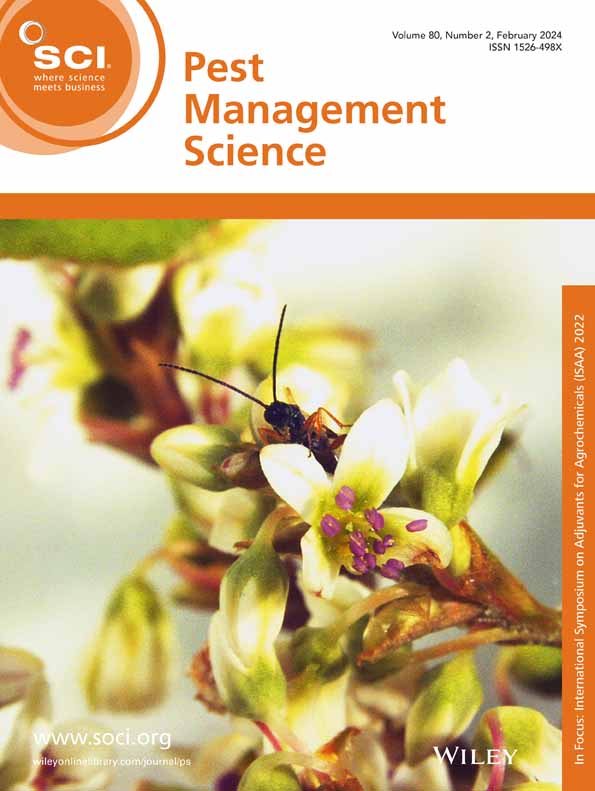柑橘基因型中花青素的表达降低了宿主对植物病原体载体的偏好和表现。
IF 3.8
1区 农林科学
Q1 AGRONOMY
引用次数: 0
摘要
柑桔黄龙病(Huanglongbing, HLB)是世界上最具破坏性的柑桔病害之一,由韧皮部限制细菌Candidatus Liberibacter asiaticus引起,并由亚洲柑橘木虱(Diaphorina citri)传播。目前的疾病控制战略主要依赖于使用杀虫剂来抑制病媒种群,这导致了环境问题,而且效果有限。花青素是植物次生代谢物,具有抗生物和非生物胁迫的保护作用。本研究通过将从红葡萄中克隆的转录因子VvmybA1引入墨西哥酸橙(Citrus aurantifolia),探讨了花青素过表达对柑桔寄主偏好和生产性能的影响。结果表达svmyba1的柑橘树由于花青素积累而形成紫色叶片,特别是在幼芽中。对挥发性有机化合物的比较分析显示,野生型和转基因树之间的差异很小,这表明嗅觉线索在木虱偏好中发挥的作用有限。行为学分析表明,在有视觉线索的情况下,柑桔倾向于在野生型树上着陆和定居。然而,在没有光照的情况下,木虱在野生型和转基因树之间没有表现出偏好。与野生型相比,表达vvmyba1的植株显著降低了柑橘的存活率和寿命。此外,木虱以转基因植物的韧皮部汁液为食时死亡率增加,表明有直接的毒性作用。在喂食合成花青素3-丙二醇葡萄糖苷(一种在转基因柑橘中发现的主要花青素化合物)的木虱中,死亡率也有类似的增加。结论柑橘花青素过表达降低了柑橘木虱对寄主的偏好,影响了木虱的存活。这些影响似乎主要是通过视觉威慑和直接毒性介导的,而不是嗅觉线索。通过对柑橘进行基因改造,使其过量生产花青素,减少病媒种群和限制病原体传播,是一种很有前途的HLB管理策略。需要进一步的研究来评估长期稳定性、农艺可行性以及与现有有害生物管理战略的整合。©2025化学工业协会。本文章由计算机程序翻译,如有差异,请以英文原文为准。
Expression of anthocyanins in a citrus genotype reduces host preference and performance by a phytopathogen vector.
BACKGROUND
Citrus greening, or Huanglongbing (HLB), one of the most devastating citrus diseases worldwide, is caused by the phloem-limited bacterium 'Candidatus Liberibacter asiaticus' and transmitted by the Asian citrus psyllid (Diaphorina citri). Current disease control strategies rely primarily on insecticide applications to suppress vector populations, leading to environmental concerns and limited efficacy. Anthocyanins are plant secondary metabolites known for their protective roles against biotic and abiotic stresses. This study explores the impact of anthocyanin overexpression on the host preference and performance of D. citri by introducing the transcription factor VvmybA1, cloned from red grape, into Mexican lime (Citrus aurantifolia).
RESULTS
Transgenic VvmybA1-expressing citrus trees developed purple leaves because of anthocyanin accumulation, particularly in young shoots. Comparative analysis of volatile organic compounds revealed minimal differences between wild-type and transgenic trees, suggesting that olfactory cues play a limited role in psyllid preference. Behavioral assays showed that D. citri preferred to land and settle on wild-type trees when visual cues were available. However, in the absence of light, psyllids exhibited no preference between wild-type and transgenic trees. Survival and lifespan of D. citri were significantly reduced on VvmybA1-expressing plants compared with wild-type trees. In addition, psyllid mortality increased when fed on phloem sap extracted from transgenic plants, suggesting a direct toxic effect. A similar increase in mortality was observed in psyllids fed synthetic cyanidin 3-malonyl glucoside, a major anthocyanin compound found in the transgenic citrus.
CONCLUSION
Our findings indicate that anthocyanin overexpression in citrus reduces D. citri host preference and negatively impacts psyllid survival. These effects appear to be primarily mediated through visual deterrence and direct toxicity rather than olfactory cues. The genetic modification of citrus to overproduce anthocyanins presents a promising strategy for HLB management by reducing vector populations and limiting pathogen transmission. Further research is needed to assess long-term stability, agronomic feasibility, and integration with existing pest management strategies. © 2025 Society of Chemical Industry.
求助全文
通过发布文献求助,成功后即可免费获取论文全文。
去求助
来源期刊

Pest Management Science
农林科学-昆虫学
CiteScore
7.90
自引率
9.80%
发文量
553
审稿时长
4.8 months
期刊介绍:
Pest Management Science is the international journal of research and development in crop protection and pest control. Since its launch in 1970, the journal has become the premier forum for papers on the discovery, application, and impact on the environment of products and strategies designed for pest management.
Published for SCI by John Wiley & Sons Ltd.
 求助内容:
求助内容: 应助结果提醒方式:
应助结果提醒方式:


